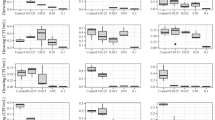Abstract
The lichens are the smallest ecosystem model sharing a life cycle with combination of a fungus and at least one or two algae. The two control and facilitate the lives of lichens mutually. An attempt has been made here to provide informatıon on the basic structural and metabolic characteristics of lichens in the light of basic sources. The use of lichens from the past to the present and their importance has been highlighted together with the effects of lichen metabolites as well as their importance of the role these organisms play in the nature. Lichen systematics, revision studies on various genera, and biological effects of lichen products have also been investigated in Turkey for nearly past five decades, and these studies too have been evaluated.
Access this chapter
Tax calculation will be finalised at checkout
Purchases are for personal use only
Similar content being viewed by others
References
Al-Amoody AA, Yayman D, Kaan T et al (2020) Role of lichen secondary metabolites and pigments in uv-screening phenomenon in lichens. Acta Biologica Turcica 33(1):35–48
Ari F, Ulukaya E, Oran S et al (2015) Promising anticancer activity of a lichen, Parmelia sulcata Taylor, against breast cancer cell lines and genotoxic effect on human lymphocytes. Cytotechonology 67:531–543
Armstrong R (2004) Lichens, Lichenometry and global warming Microbiologist (September) 32–35
Bačkorová M, Jendželovsky R, Kello M et al (2012) Lichen secondary metabolites are responsible for induction of apoptosis in HT-29 and A2780 human cancer cell lines. Toxicol In Vitro 26:462–468
Brodo IM, Duran-Sharnoff S, Sharnoff S (2001) Lichens of North America. Yale University Press, New Haven/London
Ceker S, Orhan F, Kizil HE et al (2015) Genotoxic and antigenotoxic potentials of two Usnea species. Toxicol Ind Health 31(11):990–999
Culberson CF, Culberson WL (2001) Future directions in lichen chemistry. Bryologist 104(2):230–234
Goga M, Elecko J, Marcincinova M et al (2018) Lichen metabolites: An overview of some secondary metabolites and their biological potential. In: Merillon JM, Ramawat KG (eds) Co-evolution of secondary metabolites. Springer Nature, Cham
Gupta V, Vaidesvaran SC, Dobhal DP (2014) Colonization delay of Rhizocarpon geographicum: study from the Gangotri Glacier, Northwestern Himalaya. J Geol Soc India 84:335–340
John V, Türk A (2017) List of Turkish lichens. Ali Nihat Gökyiğit Foundation, Nezahat Gökyiğit Botanical Garden Publication, NAMAŞ- İstanbul, Turkey
Joshi S, Upreti DK, Das P, Nayaka S (2012) Lichenometry: a technique to date natural hazards. Earth Sci India II:1–6
Karabulut G, Ozturk S (2015) Antifungal activity of Evernia prunastri, Parmelia sulcata, Pseudevernia furfuracea var furfuracea. Pakistan J Bot 47(4):1575–1579
Marques J (2013) A frame for assessing the vulnerability of schist surface to lichen-induced weathering in the upper Douro region (NE Portugal). Faculty of Science, Biology Department, University of Porto
Nascimbene J, Nimis PL, Ravera S (2013) Evaluating the conservation status of epiphytic lichens of Italy: a red list. Plant Biosystems 147(4):898–904
Nash H III (2008) Lichen Biology, 2nd edn. Cambridge University Press, London
Nash H III, Ryan D, Diederich P, Gries C, Bungartz F (2002) Lichen Flora of the greater Sonoran Desert region, vol 1. Lichens Unlimited, Tempe
Palmqvist K (2000) Carbon economy in lichens. New Phytol 148:11–36
Palmqvist K, Dahlman L, Valladares F et al (2002) CO2 exchange and thallus nitrogen across 75 contrasting lichen associations from different climate zones. Oecologia 133:295–306
Price S, Long SP (1989) An in vivo analysis of the effect of SO2 fumigation on photosynthesis in Zea mays. Physiol Plant 76:193–200
Price GD, Badger MR, Woodger FJ, Long BM (2008) Advances in understanding the cyanobacterial CO2 - concentrating - mechanism (CCM): functional components, Ci transporters, diversity, genetic regulation and prospects for engineering into plants. J Exp Bot 59(7):1441–1461
Randlane T, Jüriado I, Suija A et al (2008) Lichens in the new red list of Estonia. Folia Cryptog Ectonica, Fasc 44:113–120
Rankovič B (2015) Lichen secondary metabolites. Springer, Cham
Rundel PW (1978) The ecological role of secondary lichen substances. Biochem Syst Ecol 6:157–170
Scheidegger C, Werth S (2009) Conservation strategies for lichens: insights from population biology. Fungal Biol Rev 23:55–66
Smith CW, Aptroot A, Coppins BJ et al (2009) The lichens of Great Britain and Ireland. British Lichens Society, London
Wirth V, Hauck H, Schultz M (2013) Die Flechten Deutschland. Vol. 1 and 2, Ulmer Verlag
Yavuz M, Özyiğitoğlu G (2015) Tıp tarihinde likenlerle ilgili terimler. Avrasya Terim Dergisi 3(1):1–9
Zeytinoglu H, Incesu Z, Tuylu BA et al (2008) Determination of genotoxic, antigenotoxic and cytotoxic potential of the extract from lichen Cetraria aculeata (Schreb.) Fr. In vitro. Phytother Res 22:118–123
Zheng X-L, Sheng H-M, An L-Z (2007) Phylogenetic analysis of lichen - forming fungi Rhizoplaca Zopf from China based on ITS data and morphology. Z Naturforsch 62:757–764
Zhou Q-M, Guo S-Y, Huang M-R, Wei J-C (2006) A study of the genetic variability of Rhizoplaca chrysoleuca using DNA sequences and secondary metabolic substances. Mycologia 98(1):57–67
Author information
Authors and Affiliations
Corresponding author
Editor information
Editors and Affiliations
Rights and permissions
Copyright information
© 2021 Springer Nature Switzerland AG
About this chapter
Cite this chapter
Öztürk, Ş. (2021). Lichens: Characteristics, Importance, Uses, and Distribution in Turkey. In: Öztürk, M., Altay, V., Efe, R. (eds) Biodiversity, Conservation and Sustainability in Asia. Springer, Cham. https://doi.org/10.1007/978-3-030-59928-7_3
Download citation
DOI: https://doi.org/10.1007/978-3-030-59928-7_3
Published:
Publisher Name: Springer, Cham
Print ISBN: 978-3-030-59927-0
Online ISBN: 978-3-030-59928-7
eBook Packages: Biomedical and Life SciencesBiomedical and Life Sciences (R0)




